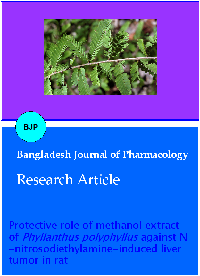Protective role of methanol extract of Phyllanthus polyphyllus against N-nitrosodiethylamine-induced liver tumor in rat
DOI:
https://doi.org/10.3329/bjp.v5i2.6750Keywords:
Phyllanthus polyphyllus, Liver Tumor, N-nitrosodiethylamine, Glycoproteins, Phase I enzymes, Phase II enzymes.Abstract
The protective role of methanol extract of Phyllanthus polyphyllus was evaluated in N-nitrosodiethylamine-induced experimental liver tumor in male Wistar albino rats. Administration of extract (200 and 400 mg/kg) effectively suppressed liver tumor as revealed by decrease in elevated levels of Phase I enzymes like cytochrome P450, cytochrome b5, NADPH-cytochrome P450 reductase and glycoproteins like hexose, hexoseamine and sialic acid. The extract produced an increase in phase II enzymes like UDP-glucuronyl transferase and glutathione-S-transferase levels when compared to liver tumor bearing animals. This study suggests that methanol extract of P. polyphyllus may extend its protective role by modulating the levels of glycoproteins and phase I metabolizing enzymes and augmenting phase II metabolizing enzymes.
Downloads
215
144 Read
8
References
Habig WH, Pabst MJ, Jakoby WB. Glutathion S-transferase, the first enzymatic step in mercapturic acid formation. J Biol Chem. 1974; 249: 7130-39.
Hartman PE, Shankel DW. Antimutagens and anticarcinogens: A survey of putative interceptor molecules. Environ Mol Mutagen. 1990; 15: 145-82.
Herzfeld A, Greengard O. The effect of lymphoma and other neoplasms on hepatic and plasma enzymes of the host rat. Cancer Res. 1997; 37: 231-38.
Hollmann S, Touster O. Alterations in tissue levels of uridine diphosphate glucose dehydrogenase, uridine diphosphate glucuronic acid pyrophosphatase and glucuronyl transferase induced by substances influencing the production of ascorbic acid. Biochim Biophys Acta. 1962; 62: 338-52.
Jeena KJ, Joy KK, Kuttan R. Effect of Emblica officinalis, Phyllanthus amarus and Picrorrhiza kurroa on N-nitrosodiethylamine-induced hepatocarcinogenesis. Cancer Lett. 1999; 136: 11-16.
Lu CQ, Lu J, Wangb L, Cui Y. Changes in ganglioside contents, plasma sialic acid and cAMP levels in experimental hepatoma in mice. Mol Cell Biochem. 2000; 207: 2933.
Mathew KM. The flora of the Tamilnadu Carnatic. Vol. 3. The Rapinet Herbarium, St. Joseph's College, Trichirapalli, 1983, p 1468.
Niebes P. Determination of enzymes and degradation products of glycosaminoglycan metabolism in the serum of healthy and varicose subjects. Clin Chim Acta. 1972; 42: 399-408.
Omura T, Sato R. The carbon monoxide-binding pigment of liver microsomes. Evidence for its hemoprotein nature. J Biol Chem. 1964; 239: 2370-78.
Peers PG, Linsell CA. Dietary aflatoxins and liver cancer: A population based study in Kenya. Br J Cancer. 1973; 27: 473-84.
Rajkapoor B, Venugopal R, Sakthisekaran D, Zhang HQ, Nishigaki I. Protective effect of Phyllanthus polyphyllus on human umbilical vein endothelial cells against glycated protein-iron chelate induced toxicity. J Med Sci. 2007; 7: 961-68.
Rajkapoor B, Sankari M, Sumithra M, Anbu J, Harikrishnan N, Gobinath M, Suba V, Balaji R. Antitumor and cytotoxic effects of Phyllanthus polyphyllus on Ehrlich ascites carcinoma and human cancer cell lines. Biosci Biotechnol Biochem. 2007; 71: 2177-83.
Rao YK, Fang SH, Tzeng YM. Anti-inflammatory activities of constituents isolated from Phylanthus polyphyllus. J Ethnopharmacol. 2006; 103: 181-86.
Reed DJ. Glutathione: Toxicological implications. Ann Rev Pharmacol Toxicol. 1990; 30: 603-31.
Thirunavukkarasu C, Prince Vijeya Singh J, Thangavel M, Selvendiran K, Sakthisekaran D. Dietary influence of selenium on the incidence of N-nitrosodiethylamine-induced hepatoma with reference to drug and glutathione metabolizing enzymes. Cell Biochem Funct. 2002; 20: 347-56.
Thirunavukkarasu C, Sakthisekaran D. Influence of sodium selenite on glycoprotein contents in normal and N-nitrosodiethylamine initiated and phenobarbital promoted rat liver tumors. Pharmacol Res. 2003; 48: 167-71.
Williams CH Jr, Kamin H. Microsomal triphosphopyridine nucleotide-Cytochrome c reductase of liver. J Biol Chem. 1962; 237: 587-95.
Wagner WD. A more sensitive assay discriminating galactosamine and glucosamine in mixtures. Anal Biochem. 1979; 94: 394-96.
Warren L. The thiobarbituric acid assay of sialic acids. J Biol Chem. 1959; 234: 1971-75.
Yoshiji H, Nakae D, Kinugasa T, Matsuzaki M, Denda A, Suiji T. Inhibitory effect of the iron deficiency on the induction of putative preneoplastic foci rat liver initiated with diethylnitrosamine and promoted by phenobarbital. Br J Cancer. 1991; 64: 939-82.
Youkwan J, Srisomphot P, Sutthivaiyakit S. Bioactive constituents of the leaves of Phyllanthus polyphyllus. J Nat Prod. 2005; 68: 1006-09.

Additional Files
Published
How to Cite
Issue
Section
License
Authors who publish with this journal agree to the following terms:
- Authors retain copyright and grant the journal right of first publication with the work simultaneously licensed under a Creative Commons Attribution License that allows others to share the work with an acknowledgement of the work's authorship and initial publication in this journal.
- Authors are able to enter into separate, additional contractual arrangements for the non-exclusive distribution of the journal's published version of the work (e.g., post it to an institutional repository or publish it in a book), with an acknowledgement of its initial publication in this journal.
- Authors are permitted and encouraged to post their work online (e.g., in institutional repositories or on their website) prior to and during the submission process, as it can lead to productive exchanges, as well as earlier and greater citation of published work (See The Effect of Open Access).
